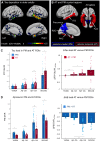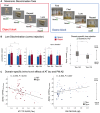Alzheimer's pathology targets distinct memory networks in the ageing brain
- PMID: 31199481
- PMCID: PMC6658874
- DOI: 10.1093/brain/awz154
Alzheimer's pathology targets distinct memory networks in the ageing brain
Abstract
Alzheimer's disease researchers have been intrigued by the selective regional vulnerability of the brain to amyloid-β plaques and tau neurofibrillary tangles. Post-mortem studies indicate that in ageing and Alzheimer's disease tau tangles deposit early in the transentorhinal cortex, a region located in the anterior-temporal lobe that is critical for object memory. In contrast, amyloid-β pathology seems to target a posterior-medial network that subserves spatial memory. In the current study, we tested whether anterior-temporal and posterior-medial brain regions are selectively vulnerable to tau and amyloid-β deposition in the progression from ageing to Alzheimer's disease and whether this is reflected in domain-specific behavioural deficits and neural dysfunction. 11C-PiB PET and 18F-flortaucipir uptake was quantified in a sample of 131 cognitively normal adults (age: 20-93 years; 47 amyloid-β-positive) and 20 amyloid-β-positive patients with mild cognitive impairment or Alzheimer's disease dementia (65-95 years). Tau burden was relatively higher in anterior-temporal regions in normal ageing and this difference was further pronounced in the presence of amyloid-β and cognitive impairment, indicating exacerbation of ageing-related processes in Alzheimer's disease. In contrast, amyloid-β deposition dominated in posterior-medial regions. A subsample of 50 cognitively normal older (26 amyloid-β-positive) and 25 young adults performed an object and scene memory task while functional MRI data were acquired. Group comparisons showed that tau-positive (n = 18) compared to tau-negative (n = 32) older adults showed lower mnemonic discrimination of object relative to scene images [t(48) = -3.2, P = 0.002]. In a multiple regression model including regional measures of both pathologies, higher anterior-temporal flortaucipir (tau) was related to relatively worse object performance (P = 0.010, r = -0.376), whereas higher posterior-medial PiB (amyloid-β) was related to worse scene performance (P = 0.037, r = 0.309). The functional MRI data revealed that tau burden (but not amyloid-β) was associated with increased task activation in both systems and a loss of functional specificity, or dedifferentiation, in posterior-medial regions. The loss of functional specificity was related to worse memory. Our study shows a regional dissociation of Alzheimer's disease pathologies to distinct memory networks. While our data are cross-sectional, they indicate that with ageing, tau deposits mainly in the anterior-temporal system, which results in deficits in mnemonic object discrimination. As Alzheimer's disease develops, amyloid-β deposits preferentially in posterior-medial regions additionally compromising scene discrimination and anterior-temporal tau deposition worsens further. Finally, our findings propose that the progression of tau pathology is linked to aberrant activation and dedifferentiation of specialized memory networks that is detrimental to memory function.
Keywords: anterior-temporal (AT); hyperactivation; memory; posterior-medial (PM); tau.
© The Author(s) (2019). Published by Oxford University Press on behalf of the Guarantors of Brain. All rights reserved. For Permissions, please email: journals.permissions@oup.com.
Figures






Similar articles
-
Early stages of tau pathology and its associations with functional connectivity, atrophy and memory.Brain. 2021 Oct 22;144(9):2771-2783. doi: 10.1093/brain/awab114. Brain. 2021. PMID: 33725124 Free PMC article.
-
Tau PET patterns mirror clinical and neuroanatomical variability in Alzheimer's disease.Brain. 2016 May;139(Pt 5):1551-67. doi: 10.1093/brain/aww027. Epub 2016 Mar 8. Brain. 2016. PMID: 26962052 Free PMC article.
-
Tau pathology and neurodegeneration contribute to cognitive impairment in Alzheimer's disease.Brain. 2017 Dec 1;140(12):3286-3300. doi: 10.1093/brain/awx243. Brain. 2017. PMID: 29053874 Free PMC article.
-
Alzheimer's Disease Neuropathological Change in Aged Non-Primate Mammals.Int J Mol Sci. 2024 Jul 25;25(15):8118. doi: 10.3390/ijms25158118. Int J Mol Sci. 2024. PMID: 39125687 Free PMC article. Review.
-
White matter hyperintensities are higher among early-onset Alzheimer's disease participants than their cognitively normal and early-onset nonAD peers: Longitudinal Early-onset Alzheimer's Disease Study (LEADS).Alzheimers Dement. 2023 Nov;19 Suppl 9(Suppl 9):S89-S97. doi: 10.1002/alz.13402. Epub 2023 Jul 25. Alzheimers Dement. 2023. PMID: 37491599 Free PMC article. Review.
Cited by
-
Entorhinal-Hippocampal Circuit Integrity Is Related to Mnemonic Discrimination and Amyloid-β Pathology in Older Adults.J Neurosci. 2022 Nov 16;42(46):8742-8753. doi: 10.1523/JNEUROSCI.1165-22.2022. Epub 2022 Oct 27. J Neurosci. 2022. PMID: 36302636 Free PMC article.
-
Functional Network Alterations Associated with Cognition in Pre-Clinical Alzheimer's Disease.Brain Connect. 2023 Jun;13(5):275-286. doi: 10.1089/brain.2022.0032. Epub 2023 Mar 17. Brain Connect. 2023. PMID: 36606679 Free PMC article.
-
A remote digital memory composite to detect cognitive impairment in memory clinic samples in unsupervised settings using mobile devices.NPJ Digit Med. 2024 Mar 26;7(1):79. doi: 10.1038/s41746-024-00999-9. NPJ Digit Med. 2024. PMID: 38532080 Free PMC article.
-
Protocol: Prospective evaluation of feasibility, added value and satisfaction of remote digital self-assessment for mild cognitive impairment in routine care with the neotivCare app.BMJ Open. 2024 Mar 12;14(3):e081159. doi: 10.1136/bmjopen-2023-081159. BMJ Open. 2024. PMID: 38479732 Free PMC article.
-
Cognitive reserve against Alzheimer's pathology is linked to brain activity during memory formation.Nat Commun. 2024 Nov 13;15(1):9815. doi: 10.1038/s41467-024-53360-9. Nat Commun. 2024. PMID: 39537609 Free PMC article.
References
-
- Albert MS, DeKosky ST, Dickson D, Dubois B, Feldman HH, Fox NC et al. . The diagnosis of mild cognitive impairment due to Alzheimer’s disease: recommendations from the National Institute on Aging-Alzheimer’s Association workgroups on diagnostic guidelines for Alzheimer’s disease. Alzheimers Dement 2011; 7: 270–9. - PMC - PubMed
Publication types
MeSH terms
Substances
Grants and funding
LinkOut - more resources
Full Text Sources
Other Literature Sources
Medical
Research Materials

